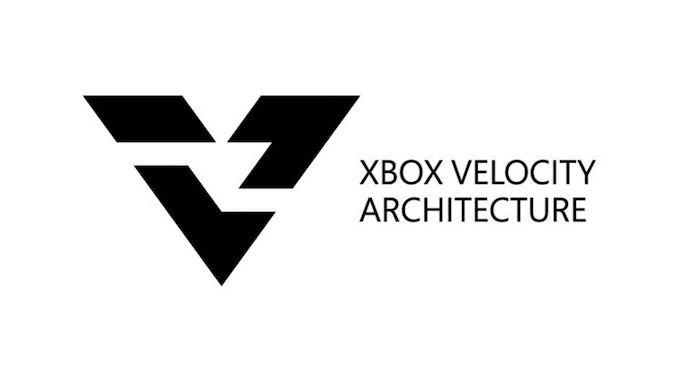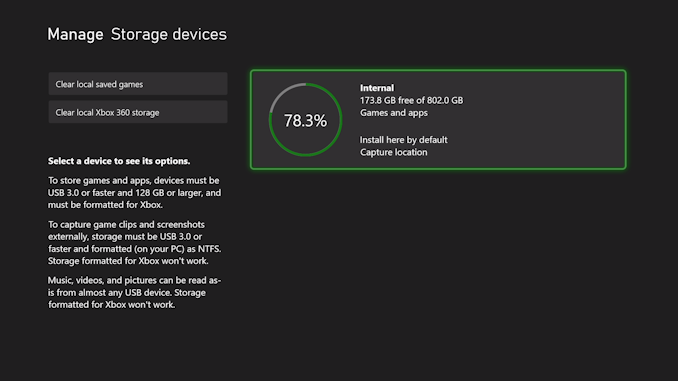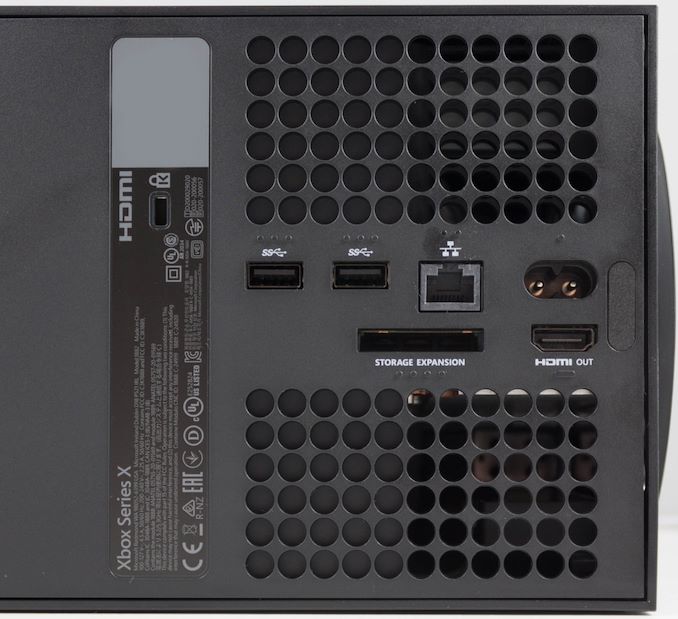The Xbox Series X Review: Ushering In The Next Generation of Game Consoles
by Brett Howse on November 5, 2020 9:00 AM ESTXbox Velocity Architecture
A lot of buzz has been made about the fact that both Microsoft and Sony have moved to solid-state storage with this round of consoles, and for good reason. Flash-based storage offers far more performance than the spinning hard disk drives that came before, in both sequential read/write, as well as random read/write. That being said, Microsoft and Sony have taken different approaches to the task, with Sony opting to put a lot of their eggs in bleeding-edge storage performance, and Microsoft opting for more conventional flash storage with their own tweaks in hardware to suit a console workload. Each will have its own advantages and disadvantages, but no matter what anyone thinks, you can’t drive pixels with a SSD, so Microsoft opting to put more of their Xbox budget into the GPU is not a bad thing.
For a complete breakdown on what each company is doing, please check out this article Billy Tallis wrote in June, explaining each company's storage decisions and the rationales behind them.
The move to SSD storage brings about a world of improvements to the Xbox Series X, and Microsoft has dubbed their storage implementation the Xbox Velocity Architecture. This encompasses four key components, the first of which is the NVMe SSD itself which can handle 2.4 GB/s of uncompressed data. But to connect it to the system, and reduce CPU overhead, there is also a hardware decompression block, an new API called DirectStorage, and Sample Feedback Streaming, which allows games to load into memory only the exact portions of textures required to actually render a scene. A single 4K-quality texture is around 8 MB in size – even with texture compression – so being able to grab portions of textures as needed will reduce the strain on the SSD and the memory pool. Microsoft calculates that Sample Feedback Streaming on its own is an average 2.5x multiplier on how much memory is in the console, and the same 2.5x on SSD performance.
All this SSD performance brings a lot of benefits. The first one you will notice is the boot time.
With the Xbox Series X in its Energy-Savings mode, which means it is fully powered off, it boots up to the dashboard, ready to play, in just eight seconds. You read that correctly: eight seconds for a cold boot. Compare that to the Xbox One X.
The older console with a rotating rust hard drive clocks in a hair under a minute to go from fully off to ready to use. The speed difference is staggering and changes the way you can use the console. Both generations offer an “instant-on” mode, which puts the console to sleep instead of off, allowing for much faster resume times of just a few seconds, but at the cost of extra power draw while sleeping. The Xbox Series X boots so fast that you can get the benefit of being powered-down without sacrificing the boot time. That is a nice change.
Load times for games are also dramatically improved. With the move to 4K gaming on the Xbox One X, load times took a noticeable hit as the textures required for higher-resolution gaming are much larger than 1920x1080 textures. A game like Forza Motorsports 7 would take minutes to load tracks, which is now done in a handful of seconds.
There is no overstating how much of an impact this has on a gaming session. Waiting minutes for a track to load is not an immersive experience.
The beauty of moving to NVMe flash storage is that all existing games will benefit with no work required by the developer. Load times will be reduced, and owners will enjoy the benefits. Another great example of this is Red Dead Redemption 2, which also took minutes to load on the Xbox One X.
This is not quite as instantaneous as the Forza 7 example, since RDR2 is such a massive game, but it certainly makes for a much more enjoyable experience when having to load the game from the beginning.
But what if you did not have to load the game from the beginning at all? The Xbox Series X|S, thanks to the great performance of the storage, are implementing a feature called Quick Resume. If you owned a previous generation console, you are likely aware that if you closed a game by going to the home screen, the game was suspended in memory. As long as you did not open another game, you could go back to that game, even if the console was powered off and Instant-On mode was set, as the memory would be active and the game would be instantly available right where you left off. Thanks to the extra performance from the solid-state drive, Quick Resume will quickly write the active contents of the game’s memory to storage. The entire contents of memory can be written to storage in just a couple of seconds, and when loading from memory, it also just takes a couple of seconds to get back to exactly where you left off, even if the console was completely powered off.
No developer involvement is required for Quick Resume either, so this feature is available across all games, including Xbox One games via backwards compatibility. This is one of the key features that really makes you sit up and take notice. You can switch between active games in just a couple of seconds and be back to exactly where you were. It is a liberating feeling.
With 2.4 GB/s sustained raw performance, and 4.8 GB/s of compressed data transfer speeds, the new Xbox Velocity Architecture is the most noticeable change when moving from a previous generation console to the Xbox Series X. As games evolve, worlds should be able to be even larger, as developers will be able to swap textures more quickly in and out of memory as needed.
The Xbox Series X is currently a 1 TB console, and the Xbox Series S ships as a 512 GB console. Those numbers are, as is unfortunately industry practice, base 10 values instead of base 2. Plus, the system itself must reserve some of the space for the operating system and storage for game files and such. The Xbox Series X offers 802 GB of unused storage for game and app downloads, and the Series S has 364 GB usable. Unfortunately, due to the console and games expecting NVMe storage, using a USB hard drive for additional storage is no longer as simple of an option. Games can still be stored on USB drives, but titles specifically enhanced for the X|S architecture can only be run off of the internal storage, so some fussing around may be required to keep games in long-term storage on USB drives, and then swap them to internal when needed.
The other option is to increase the NVMe storage. Microsoft has opted to allow an add-in card for additional storage via a connector on the back of the Xbox. Currently, there is a 1 TB expansion option from the long-time Xbox partner Seagate. If and when other options will be available is unknown, but if you absolutely need more storage, an extra 1 TB is a decent amount. You would have to think that the amount available, as well as pricing, will drop over time, but it is not a standard M.2 PC part, so prices will always carry a premium.
The faster storage will not outright create better graphics, although it should allow game worlds to become more expansive. But, the quality of life improvements that have come to the Xbox Series X, thanks to the Xbox Velocity Architecture, really changes the way the console can be used, and the differences can not be understated. Everything is faster, from boot times, to loading times, and add in the new Quick Resume function, and gaming is far more enjoyable on the Xbox Series X than it ever was on any previous Xbox.
AV Connections
Better graphics, faster storage, and a weird shape. The Xbox Series X has a lot going for it, but how do you actually connect it to your TV? As already mentioned, the Xbox Series X|S has dropped the HDMI input, but as a reward (not really) you get an HDMI 2.1 output. HDMI 2.1 allows for 4K output at 120 Hz, unlike HDMI 2.0 which was capped at 60 Hz. It also allows for 8K video, although most people do not have an 8K TV yet, and there is almost no content for that.
The Xbox Series X|S, like the outgoing model, also support variable refresh rates, so if you TV or monitor supports it, you can get even smoother framerates. Most televisions do not support this yet, although some of the most recent devices do support variable refresh rates / FreeSync, as well as 120 Hz inputs.
The Xbox Series X|S also supports an automatic low-latency mode (ALLM) which will switch the TV to its lowest latency input when you start playing if the television supports it. Xbox One also supported this functionality.
Audio also gets a slight change. The Xbox has dropped the S/PDIF audio output and relies completely on HDMI for the audio stream. S/PDIF has long since been replaced with HDMI as it could not handle the bitrate required for the more modern lossless audio codecs and 7 channel surround, so this is not a surprise, but if you were hoping to leverage optical audio to connect to a receiver, you will sadly be out of luck.
Microsoft has put a fair amount of extra silicon into their SoC just to handle audio, with games being able to support positional audio such as Dolby Atmos and DTS:X, and developers will be able to leverage Microsoft’s Project Acoustics as well thanks to the new audio hardware baked into the silicon. As an aside, there are reports that the Xbox Series X|S will not work with certain receivers with HDMI 2.1, as their included hardware is incompatible. The issue is not with the Xbox though, but non-compliant hardware in the receivers themselves. Be aware of the issue if you currently own an HDMI 2.1 compliant receiver though and were hoping to get 120 Hz 4K video from the Xbox.













68 Comments
View All Comments
jabber - Thursday, November 5, 2020 - link
Tough call releasing a very non-essential bit of tech in the middle of a pandemic and economic downturn.Yojimbo - Thursday, November 5, 2020 - link
Gaming is strong because people are going out less, and it's not really an economic downtown. More like a big interruption. It remains to be seen what the longer-term effects are. Gaming tends to hold up well in actual economic downturns, anyway, from what I remember hearing. Evidence to expect strong sales: Typically, console sales are weak before a new console launch, but the PS4 and X Box One continued to sell well this year. And just look at how the Nintendo Switch is doing, much better than last year.cmdrdredd - Monday, November 9, 2020 - link
Not such a tough call when the Nintendo Switch and PS4 Prop have been sold out in most retail channels continuously since April.zepi - Thursday, November 5, 2020 - link
They are so badly supply side constrained, that there is really very little need to spend the marketing dollars right now.I'm sure MS and Sony will start pushing advertising once they have actually something to sell and they can really start competing for the marketshare.
steezebuscemi - Friday, November 6, 2020 - link
I haven't seen anything on TV, but also never really pay attention to free to air. But everywhere I look on the internet for the past 6-9 months has been speculation, rumours and excitement over this console gen. So it might just be where you are looking. I'm getting a PS5, I know numerous people getting Series X's, and I know a heap that missed out on preorders for either.Zagor Te Nay - Monday, November 9, 2020 - link
Don't know, my environment (friends and colleagues) are quite excited... but more about PS5 that XSX.I feel MS took some - or a lot - of edge from the hype with their approach. Games available on older Xbox, new Xbox, PC, and then mushed up in easy to digest subscription. It just doesn't let new consoles stand out of the crowd much, it feels more like "one of many". Plus, there is no real look-what-it-can-do title on launch. Maybe new Forza or something would raise excitement a bit, but as it is, lineup is a bit lackluster.
I work in IT company, so yeah - geeky environment. I hear chitchats about Miles Morales, DualSense, GT7 wishes, fears and expectations... but not much about new Xbox. I know it is anecdotal, still it holds some value for people in my circle; everyone from the circle, looking for new console, will be getting PS5 - as the things are now. I'm yet to hear one person who has set targets on XSX. It also doesn't help that many are PC gamers, too.
d0x360 - Wednesday, November 18, 2020 - link
I'm pretty excited...well I was, I already have my series x so now I'm just happy. Especially since I won't be able to get my hands on an amd 5900 and a 6900xt until probably March due to supply.Jorgp2 - Thursday, November 5, 2020 - link
>This encompasses four key components, the first of which is the NVMe SSD itself which can handle 2.4 GB/s of uncompressed data. But to connect it to the system, and reduce CPU overhead, there is also a hardware decompression block,Then there is no need for them to have used a proprietary memory card, most high end NVMe drives would have been fast enough.
Silversee - Friday, November 6, 2020 - link
It's not proprietary memory. It's a proprietary slot-based package.I surmise that they wanted a design that was plug and play for consumers and did not require opening up the case or messing with M.2 slots. So, they created the card interface.
They have indicated that other vendors may be offering compatible storage as well, so we may see market forces reducing costs.
eastcoast_pete - Thursday, November 5, 2020 - link
My "want it now" for this was significantly dampened when it became clear that Microsoft's own Flight Simulator is not available for the Series X at launch. That was/is weird, and gives me pause about availability of games that can really take advantage of the power this thing has on offer. Don't like saying it, but it looks like SONY is doing a better job there with its PS5, and I am not a PS fan.